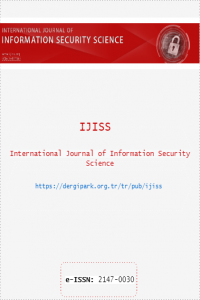Ransomware Analysis and Defense-WannaCry and the Win32 environment
Ransomware Analysis and Defense-WannaCry and the Win32 environment
Ransomware, cryptovirus, extortion, static and dynamic analysis, malware analysis cyber security,
___
- [1] Chen, Q. and Bridges, R. A. (2017). Automated behavioral analysis of malware a case study of wannacry ransomware. arXiv preprint arXiv:1709.08753.
- [2] Filiol, E. and Raynal, F. (2008). Malicious cryp- ´ tography... reloaded. In CanSecWest Conference, Vancouver, Canada.[online] http://cansecwest. com/csw08/csw08-raynal. pdf.
- [3] Kumar, S. M. and Kumar, M. R. (2013). Cryptoviral extortion: A virus based approach. International Journal of Computer Trends and Technology (IJCTT), 4(5):1149–1153.
- [4] McCormack, M. (1996). Europe hit by cryptoviral extortion. Computer Fraud & Security, 6(1996):3.
- [5] Pascariu, C., BARBU, I.-D., and Bacivarov, I. C. (2017). Investigative analysis and technical overview of ransomware based attacks. case study: Wannacry. Int’l J. Info. Sec. & Cybercrime, 6:57.
- [6] Salvi, M. H. U. and Kerkar, M. R. V. (2016). Ransomware: A cyber extortion. Asian Journal of Convergence in Technology, 2(2).
- [7] Young, A. L. (2006). Cryptoviral extortion using microsoft’s crypto api. International Journal of Information Security, 5(2):67–76.
- [8] Young, A. L. and Yung, M. (2017). Cryptovirology: The birth, neglect, and explosion of ransomware. Communications of the ACM, 60(7):24–26.
- [9] Young, A. L. and Yung, M. M. (2005). An implementation of cryptoviral extortion using microsoft’s crypto api.
- Yayın Aralığı: Yılda 4 Sayı
- Başlangıç: 2012
- Yayıncı: Şeref SAĞIROĞLU
Review of Evidence Collection and Protection Phases in Digital Forensics Process
Yesim Ulgen SONMEZ, Asaf VAROL
Ransomware Analysis and Defense-WannaCry and the Win32 environment
Efficient Big Integer Multiplication in Cryptography
Murat Burhan İLTER, Murat CENK
